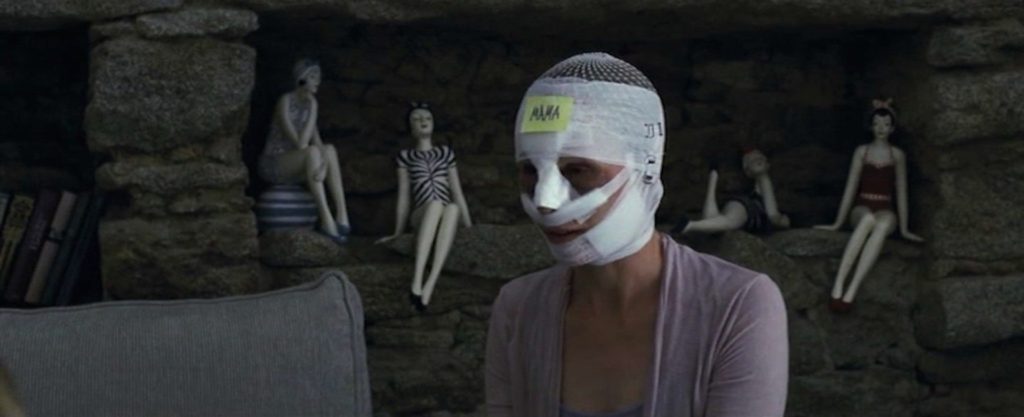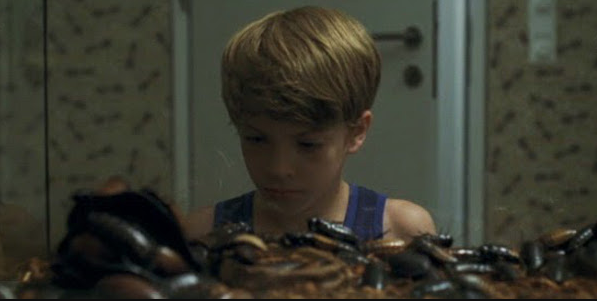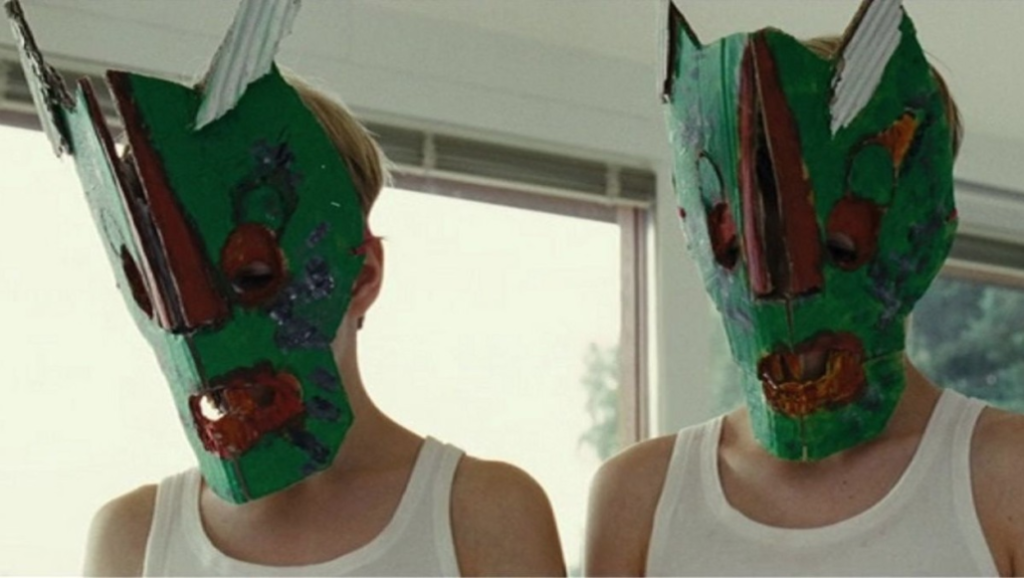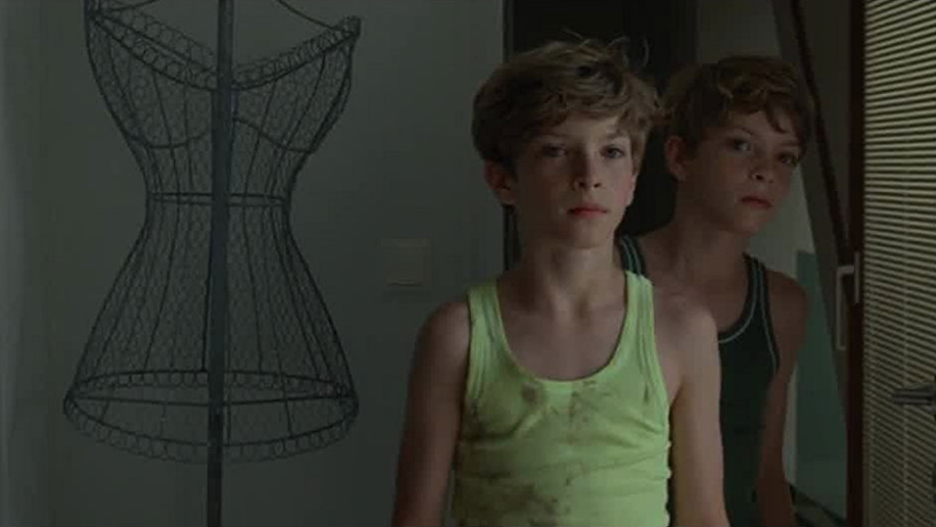
This January, in support of the Toronto Rape Crisis Centre / Multicultural Women Against Rape, friends and family have raised over $1,500 (which, when matched by my employer, totals $3,000). As a result, I now have to watch and write about thirty-one horror movies: one each night. Any donors who contributed over $30 were given the option to choose one of the horror movies I must subject myself to. After each viewing, I will write some things about said movies on this website. Be forewarned that all such write-ups will contain spoilers, and many of them will refer to unpleasant and potentially triggering situations. Today’s film is the recent Austrian creep-fest, Goodnight, Mommy, directed by Severin Fiala and Veronika Franz. I rented Goodnight, Mommy (or Ich seh ich seh) from the extensive selection from Bay Street Video.
What happens:
Trigger warnings: violence against children, torture.
Goodnight, Mommy opens as I assume all Austrian films do: with a clip from what must be the German-language version of the Von Trapps story – the one that, in The Sound of Music, features that “So long, farewell, Auf wiedersehen, goodbye …” Then we follow (as we do for the majority of the film) pre-teen twin boys – Elias and Lukas (Elias and Lukas Schwarz) – as they romp through the idyllic Austrian countryside. They play tag while wearing homemade cardboard goblin masks, they jump on the spongy earth, they explore tunnels. Their mother (Suzanne Wuest) returns to their remote home after a facial operation, her face covered in bandages. Only her mouth and two heavily bruised eyes show. The twins seem a bit spooked by their mom’s new appearance. She closes the blinds and directs the two boys to take a bath.
Right off the bat, we see the mother treat Lukas differently than Elias. Lukas won’t speak directly to his mom, and, in turn, she only makes supper for Elias. “He knows why,” Mom says. Elias encourages Lukas to apologize, but he won’t. The family plays a DIY version of Hedbanz. When Elias writes “MAMA” on a Post-it note and adheres it to the bandages over his mother’s forehead, we learn a few things about Mom. For instance, she’s a sort-of famous Austrian TV hostess. However, the game stumps completely stumps her. She can’t guess “mom,” even after multiple clues.

One of the boys finds a roach in the bathroom and places it inside their terrarium of hissing roaches. (Every boy needs a hobby.) The mom, dressed in a yellow striped robe, outlines new rules for the house. The surgeon warned her she needs lots of rest, so there are to be no visitors, no loud noises, and the blinds are to be closed at nearly all times. After the loss of their father, she is determined to keep the family together. But that night, Elias and Lukas whisper to each other in the dark. Mom seems very different. Maybe it’s just the effects of the operation, or maybe it’s something else. They play a recording of their mom (pre-operation) singing their favourite lullaby and drift off to sleep.
That night, Elias wakes and sneaks out of the bedroom in the middle of the night. He spies his mom, bandages off, applying cream to her still-hidden face. She catches him looking in the mirror with her angry red eye and the boy skulks away. The boys have a day of frivolity in the rain – trampolines, burping contests, and more. The doorbell rings, and Elias tries to wake his mother from her rest, but she won’t get up. The twins decide to let in the visitor, a delivery man with about year’s supply of pepperoni pizza. The next day, the twins find a berm or funeral mound with a secret entrance. They venture inside, finding not only human bones (which don’t seem to alarm them in the least), but also a brown-and-orange cat. They decide to take the cat home and make it their pet. (Won’t the hissing cockroaches be jealous?)

Knowing their mom (if she is their mom) won’t let them keep the cat, the boys lock their bedroom. This upsets Mother, who demands entry and then searches the room for contraband. She finds a Coke bottle and lighter, but when she stoops to look under the bed, Elias claps loudly in front of her face to distract her from the cat hiding underneath. She leaps on top of him, pressing his face into the lower bunk bed, but releases her grip when the other twin shouts, “Mama!”
In a dream that the twins seem to share, the boys’ mother wanders into the woods in only her underwear. She disrobes completely, then unravels her bandages. We don’t see her face, because as the camera pans, her head begins to spasm and spin, like in Jacob’s Ladder. The twins then take one of their pet roaches and release it on their sleeping mom. The roach skitters all over her face, then crawls into her mouth.
The twins pore over family photos for evidence that their mom has changed. Quite a few photos are missing, but they find one piece of damning evidence: a snapshot of their mother with another woman who looks nearly identical. They pocket the photo for later use and use their mother’s laptop to look up their house on the internet. Someone seems to have placed their house on all the Austrian real estate pages. The twins’ paranoia increases: Elias decides to hide a baby monitor under his mom’s bed. During regular chores, they listen in to their mom’s phone conversation, in which she indicates she’s done “playing around.” That’s when the boys notice their pet cat, Leo, has gone missing.

The twins find Leo, deathly ill, in a corner of the basement. “I’m sure it was mom,” they agree. The boys gather all their roaches from the terrarium and dump them into a mason jar. They fill the terrarium with water (making it an aquarium), place Leo’s dead body inside, and leave it on the living room table for Mom to discover. They wait in the wings and watch their mother’s reaction. She leaves the room, returns with the jar of their precious roaches, and dumps them into the water. This does not go over well. A fight breaks out, with the twins insisting they want their mom back. Their mother thinks her children have lost their minds. When Elias asserts she’s not his mom, Mother slaps him across the face. They demand to see her birthmark, but Mom drags Elias upstairs, locks Lukas outside, and forces Elias to say (ten times) she’s his real mother. Then she insists he stop talking to his brother, Lukas. He reluctantly agrees (after being hit a couple more times). We later see Lukas tending to Elias: “She wants to tear us apart.”
The twins begin to make preparations: they sharpen the wooden arrows from a toy into sharp points with a boxcutter. They listen in to the baby monitor for anything unusual. They build a shrine to their “real mom” made of candles and a photograph. Elias goes to his mom’s room while she sleeps. He pulls back the covers and slits open her belly with the boxcutter. (This is the second film in a row to prominently feature a boxcutter.) Hundreds of roaches crawl out. Luckily, this is yet another nightmare.
When we next see the twins, they’ve got new haircuts and button-down shirts. They’ve barricaded the door to their bedroom, but pull away the obstacles when Mom knocks. She’s recovered from the facial surgery and her face looks great – almost identical to the face seen in photos earlier. She presents the boys with the gift of a new boomerang. They thank her and ask if they might play with it. As soon as Mom opens the back door, the kids run for their lives. They escape into town and eventually make their way to an old church and ask for the priest. The priest (Hans Escher) promises to drive them to the police station where they can report the impostor posing as their mother, but he tricks them (stupid kids) and brings them right back home. The priest asks the mother to explain, but she just vaguely talks about how things have been difficult since the accident and the separation.

Mother returns inside but can’t find Elias or Lukas anywhere. She eventually gives up and cries herself to sleep. She wakes in the morning to the vision of her twins in their homemade goblin masks – and the realization she’s bound to the bed. The twins have tied her down, making it impossible for her to escape. And that’s when things get torture-y. “Where is our mom?” They demand. She insists she is their mother, but they don’t accept it. They show her the photograph they saved as proof. Their mother explains an old friend of hers and she always used to dress very similarly.
The boys study old videos of their mom from TV and focus on the eye colour. They return to their bound captive and poke at her eyes. ”In the video, your eyes are brown,” they say. She explains she wore contacts on television.; they’re in the washroom. While looking for the contacts, the boys argue about whether they can believe her. When they return, they see Mom has tried to bite through her bonds, and they splash her with water as punishment.
When he’s alone with her, Elias shows her a video he recorded when she made him promise to stop talking to his brother. “Our mom wouldn’t do that.” Mom apologizes and asks Elias to free her. He begins to cut her feet loose when Lukas returns and asks what he’s doing. He demonstrates that mother’s facial birthmark easily rubs off. “They took it off in surgery!” she pleads. Elias slaps her. “You lie!”
They hold a magnifying glass to her cheek, causing it to burn a black hole in her face. They won’t let her go until she tells them where their mom is. Mother begins to cry so loudly, they tape over her mouth. And just in time, too, because the house is paid a visit by two very forward Red Cross volunteers (Elfriede Schatz and Karl Parker). When no one answer the door, the old canvassers decide to just waltz into the house (the waltz is very popular in Vienna) and snoop around. But they can’t hear the mom scream from behind the tape. The two volunteers begin to head upstairs (where the boys have tied their mother), when Elias and Lukas appear. They say their mother isn’t home, so they all decide to wait for her to arrive. (Awkward.)
After too much small talk and a few too many questions from the canvassers about life in the house, Elias steals some money from his mom’s purse and hands it to them. His mom always gives about that much; it should be all right. The female volunteer thinks it’s a lot of money, but the male volunteer advises her to look at the house. “They can afford it.” Mother is able to spit the tape off and scream for help just as the volunteers are walking back to their van, well out of earshot. The twins decide to take their gagging game next level: they Krazy Glue her mouth shut.

Later that night, they decide to undo the glue – the twins use scissors to cut through the adhesive, but end up taking some lip with it. Mother bleeds profusely from the sides of her mouth (ouch). Elias begs with her, “Please prove you’re our mom.” They ask her what Lukas’s favourite song is. She answers (or more asks), “Lullaby and goodnight?” From their grim visages, we can tell that’s not the right answer. They then sing the right answer (the lullaby from the video clip at the film’s opening). Mom begins to cry and pees herself.
An alarm goes off and the twins use a golf tee to prop open their mother’s mouth while they do some unnecessary dental work. Realizing mom has wet the bed, they untie her and force her to change the bed. (Talk about putting salt in the wound!) One twin guards her with his bow and arrow, but Mom tosses the duvet cover in their faces and makes a mad dash for the door. All the exits are locked save one. She sprints out that exit and trips on the wire they’ve placed at shin height, landing flat on her face.

When Mom awakes again, she’s tied down to the living room floor and surrounded by candles. (Her recent injuries have done a real number on her face, to boot.) Elias and Lukas, wearing their masks, set the dead cat and water diorama ablaze with a torch and make their final demand: they need to know where their mom is. Mom, in a final bid for her life, tells Elias she’ll play along if he frees her. She’ll pretend Lukas is alive again, make his breakfast – whatever he wants. And there’s the twist: Lukas is dead. He’s a figment of Elias’s imagination, the real boy having been killed in an accident that Elias was at least partially responsible for.
Mother tells Elias it wasn’t his fault that Lukas died; it was just an accident. Elias demands his mom tell him what Lukas is doing right then. His real mom would know what Lukas was doing. Lukas is holding a torch near the curtain, but, obviously, the mother can’t see that. How could she know what a nonexistent person is doing? But that answer isn’t good enough for Elias. He takes the torch from Lukas and sets the curtain aflame. The flames explode across the living room, which alarms Elias – maybe this fire got out of hand a bit quickly. Soon it engulfs Mom in flames. She dies a fiery death.
The fire department arrives. In a final dream-like shot, the twins are reunited with their mother outside the cornfield near their house.

Takeaway points:
- Elias and Lukas (or just Elias, really) seem to be suffering from a real condition called Capgras syndrome. Capgras is a psychiatric disorder in which a delusional person believes a friend, spouse, parent, or other relative has been replaced by an impostor. You’ll note that Goodnight, Mommy is not the first film in this month’s roster of horror flicks to reference Capgras syndrome. After all, it’s a staple of the Invasion of the Body Snatchers films. The primary difference is that in those films, the protagonists are not deluded. Their friends and family are being replaced. In this film, there are no pod people.
- To me, the fascinating part of the film is how the filmmakers flaunt their complete manipulation of the audience. By the end, we realize the mother is not a monster or con woman. She’s just a distressed woman who has lost most of her patience. But she’s a mother the filmmakers have turned the audience against from the very first frame. Her creepy bandaged face, her aloof demeanour, her frustration and sometimes violent outbursts – we are allied with the twins, certain this mother is not what she seems. And so, though we thought we should be afraid of impostors, we really should have been afraid of our own children the whole time. The film implicates us, much like in Haneke’s Funny Games, in someone’s torture and eventual death. (This is not one of those “feel-good” horror movies.)
- Twins, while a perfectly normal biological phenomenon, feature frequently in horror films – often introduced for sheer creepiness. From The Shining to Dead Ringers to criminally underseen Sisters, horror movies love creepy twins. Even better if they’re kids. Fittingly, the inherent unease that twins inspire comes from the same source as Capgras syndrome: the disconcerting feeling of seeing two individuals wearing the same skin.
- Goodnight, Mommy is also one of those fun movies like The Sixth Sense (spoiler alert!), where the twist end makes you recall everything that’s happened in the film so far. Did both twins drink that juice? You try to figure out if the person who didn’t really exist ever had any impact on the real world.
- In German, the title means “I see, I see,” alluding to the film’s interest in both perception versus reality and doubles.
Truly terrifying or truly terrible?: Tellingly, much of Goodnight, Mommy happens in the bright cleansing blare of total sunlight. Because rather than jump scares or scary noises in the dark, the film relies on an ongoing deep sense of dread and terror. The feeling something is very wrong, but you have no idea what until it’s far too late. So, don’t expect to be jumping out of your seat like you’er watching Paranormal Activity, but do expect to feel unease during most of the film (and a long time after).

Best outfit: If only for consistency’s sake, the jean shorts and coloured tank tops the twins wear in nearly every scene takes the cake.
Best line: “You must love pepperoni pizza.” – the delivery guy, speaking as if there are kids who don’t like pepperoni pizza.
Best kill: Well, if I didn’t say the mom being swallowed flames, I’d just be lying, wouldn’t I?
Unexpected cameo: Lead actress Susanne Wuest is a highly acclaimed Austrian actress (maybe best known for Antares), but horror fans may better know her from a small role in last year’s horror film, A Cure for Wellness
Unexpected lesson learned: Train your Red Cross and other charity volunteers to never take money from children. (Something weird is definitely happening.)
Most suitable band name derived from the movie: Capgras Syndrome. (It’s not said by name in the film, but it’d make a cool band name, right?).
Next up: The Fury (1978).